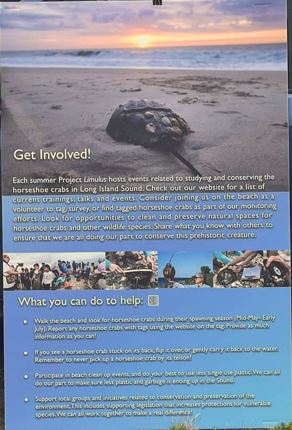Dos and Don’t
By Jennifer Budai
Dear Editor,
On June 7th, the Governor passed into law Representative Joseph Gresko’s bill HB 6484 AN ACT CONCERNING CERTAIN HARVESTING OF HORSESHOE CRABS. To prohibit the hand-harvesting of horseshoe crabs. https://www.cga.ct.gov/asp/cgabillstatus/cgabillstatus.asp?selBillType=Bill&which_year=2023&bill_num=6484 just in time for international horseshoe crab day celebrated worldwide annually on June 20th.
Meanwhile horseshoe crab spawning season is in full swing, yet many citizens are unaware of this amazing species that visits our shores to spawn annually during late spring and early summer.
Horseshoe crabs are not really a crab. They are more related to spiders and scorpians, however horseshoe crabs do not bite or sting and are not venomous. Often referred to as a living fossil, their basic body shape has remained unchanged over millions of years and they have survived five mass extinctions.
They are extremely beneficial to the world of science and medicine. If you’ve had a flu shot, given your pet a rabies vaccination, or like me, require injectable medicine such as insulin, you owe a debt of gratitude to the horseshoe crab. Vaccines, injectable drugs, intravenous solutions, and implantable medical devices, both for humans and animals, are quality-checked for safety using a test from horseshoe crab blood. Fortunately, a synthetic version is now available. Unfortunately, most injectable drugs are still tested using horseshoe crab blood.
Horseshoe crabs have survived over 400 million years and we are their main predators. We rely on them for our survival so let’s all help with their conservation! We have destroyed their habitats, over-raked our beaches and have failed to help them when they need assistance.
Their eggs bring many species of migratory shorebirds to our area — some of which are endangered. Horseshoe crabs cannot hurt you, but we often unintentionally hurt them. They bury themselves in the sand and they’re not clearly visible in brackish water.
Often they will get knocked over by large waves from boats or storms. If you see a horseshoe crab upside down, just flip them! Don’t pick them up by their tail. They break off easily and they need them to guide themselves to our shores to spawn and to help flip themselves over. Instead, gently flip them by using the side of their shell.
If you see a horseshoe crab with a tag, please report the number to US Fish and Wildlife(https://www.fws.gov/CRABTAG.. This information helps scientists track their activity and longevity.
Let’s do all that we can to help ensure their survival. And ours (more information at www.projectlimulus.org). And please, always, leave the beach cleaner than you found it.


i used to volunteer at the maritime in norwalk like holding them